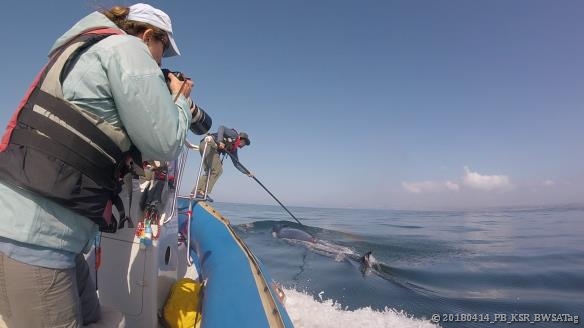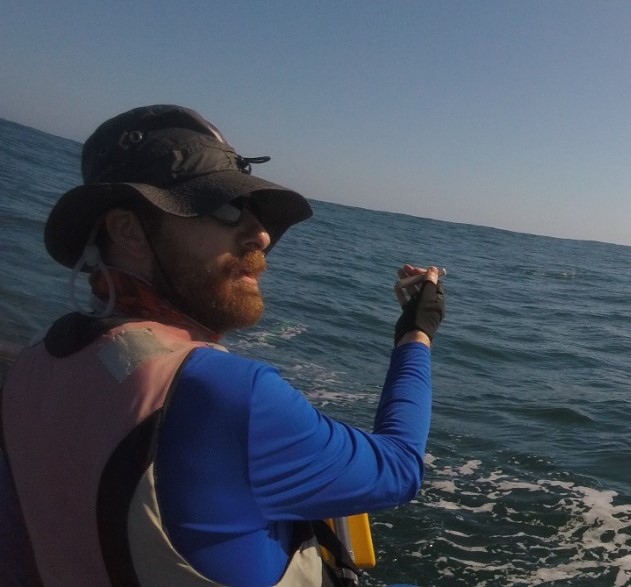Whales eat more than expected. And that’s why we need more of them
It is fifty years since humans stopped hunting whales, but the ecosystem is still not the same. New research estimates of how much whales eat suggest that past culling of the creatures by humans has contributed to broader declines in ecosystem health and productivity.
From 1910 to 1970, humans killed an estimated 1.5 million baleen whales in the frigid water encircling Antarctica. They were hunted for their blubber, baleen – the filtering fringe they have in place of teeth – and meat. One might assume that from the perspective of krill – the tiny shrimp-like creatures the whales feast on – this would be a boon. But new research published Nov. 4 in Nature from an international collaboration team led by Stanford University’s Goldbogen Lab suggests the opposite: that the decline of baleen whales in the Southern Ocean has led to a decline of krill.
The study has been carried out in a broad collaboration of international research groups - including the Behavioural Ecology Group at University of Copenhagen represented by PhD student (and latest winner of the prize for the best PhD Talk 2021) Jacopo Di Clemente.
The researchers looked at several species of rorquals – baleen whales that feed by gulping a large amount of water and filtering it through their mouths’ fringed baleen plates until only their prey remains. They employed high-tech tagging devices developed by the Goldbogen lab that attach to whales by suction cup. These stay on the whales for about five to 20 hours, recording their movements, acceleration, sound and, if light allows, video. Drones, operated by the Duke Marine Robotics and Remote Sensing Laboratory, measured the length of individual, tagged whales, which helps the researchers estimate the size of their gulp. In collaboration with the Environmental Research Division at NOAA and the University of California, Santa Cruz, the researchers also ran an underwater device called an echo sounder – which Savoca likens to “a fancy fish finder” – which uses sound waves at several different frequencies to measure how much prey is around.
- “We're looking into ways of using this information to restore ocean ecosystems and bring whales back. And hopefully, that will have benefits for everything from biodiversity conservation to fisheries yield to carbon storage.” says Matthew Savoca, a postdoctoral scholar in the Goldbogen lab at Stanford’s Hopkins Marine Station and lead author of the paper.
Analysis of the data they captured revealed that whales in the Southern Ocean eat about twice as much krill as previous estimates suggested, and that krill-feeding blue and humpback whales off the coast of California eat two to three times as much as previously thought. Fish feeding humpback whales, however, might eat the previously estimated amount or even less. This range seems to reflect the energy density of the food – whales need to eat more krill to get the same energy as they would from a smaller amount of fish.

Credits: Southern African Bryde’s whale Project
As the large baleen whales get bigger, the anatomical machinery that allows them to eat also gets relatively bigger. It seems they have evolved these systems that allow them to be eating machines. That disproportionately bigger gulp size allows them to take advantage of abundant food, like krill.
With these new consumption estimates, the researchers calculated that the early 20th- century abundance of krill in the Southern Ocean had to be about five times what it is now in order to feed the pre-whaling whale population. This implies a complex role for whales in their ecosystems where the decline or recovery of their populations is strongly tied to overall ecosystem productivity and functioning. And it shows that human activities still affect their environment.
Being able to compare data from a range of species and populations is a key element to answering fundamental research questions. With this in mind, Jacopo Di Clemente teamed up in 2017 with Dr Gwenith Penry (another co-author of the paper), Research Associate at Nelson Mandela University, to study Bryde's whales for his PhD.

Credits: Southern African Bryde’s whale Project
The goal of Di Clemente's PhD research is to describe in detail the kinematics and energetics of food acquisition in a less well-known rorqual, the Bryde´s whale, specifically, the inshore South African population to shedding light on the intrinsic and extrinsic drivers that shape their foraging techniques.
- "When it comes to rorquals, Bryde's whales are...a bit different. They don't migrate between feeding and breeding grounds the way the other species in this study do. And while they are roughly the same length as humpbacks, they have about half their engulfment capacity and seem to take way fewer gulps of fish than their fish-eating humpback cousins do."
- Jacopo says in conclusion, "It is amazing to be able to contribute to these massive comparative studies—and it's also pretty cool to have this broader context for my own species-specific work".
The Southern Ocean is among the most productive ecosystems on Earth, largely due to the abundance of microscopic algae, called phytoplankton. Phytoplankton are a vital food source for krill, small fish and crustaceans – which are, in turn, consumed by larger animals, including whales, birds and other fish. But whales also help sustain phytoplankton. Through eating krill and then defecating, whales release iron locked within krill back into the water, making that iron available to phytoplankton, which need it to survive.
The many twists and turns of these findings demonstrate the potential impact of asking simple questions. By trying to pin down how much whales eat, this work has cast doubt upon what people thought whales needed to survive, and how the activities of whales and humans affect ocean ecosystems.
Collaboration
Additional Stanford co-authors of this research include graduate students William Gough and James Fahlbusch; postdoctoral scholar Paolo Segre and Elliott Hazen, adjunct professor at Hopkins Marine Station. Other co-authors are from Cascadia Research Collective, Duke University Marine Lab, Oregon State University, Nelson Mandela University in South Africa, National Oceanic and Atmospheric Administration (NOAA)/Stellwagen Bank National Marine Sanctuary, Smithsonian National Museum of Natural History, the Burke Museum of Natural History and Culture, University of California, Santa Cruz and NOAA Southwest Fisheries Science Center.
Funding
This research was funded by the National Science Foundation, the Office of Naval Research Young Investigator Program, the Defense University Research Instrumentation Program, the National Geographic Society, the Percy Sladen Memorial Trust, the PADI Foundation, the Society for Marine Mammalogy, Torben og Alice Frimodts Fond, the Volgenau Foundation, the International Fund for Animal Welfare, and MAC3 Impact Philanthropies which is part of the Stanford One Ocean Initiative.
Emner
Kontakt
PhD student Jacopo di Clemente
Department of Biology
Mail: jacopo.diclemente@bio.ku.dk
Tel: +45 3532 7278
Helle Blæsild
PR & Communikation
Department of Biology
Mail: helleb@bio.ku.dk
Tel: +45 2875 2076
